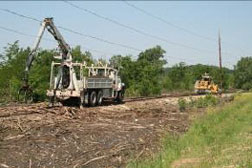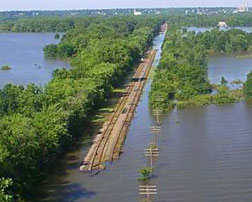 Chad Lambi, CRANDIC Flooding from the Iowa River in Iowa City. |
In the upper Midwest, railroad companies are starting a large-scale cleanup and repair of damage caused by weeks of record floods. Rail systems operated by the Iowa Northern Railway, Canadian National and eight others have experienced major delays as they rerouted shipments and customers to avoid damaged or lost bridges and track washouts.
Only Amtrak, which runs two long-distance trains through Iowa, reports no service outages due to flooding.
Among the hardest hit is the Cedar Rapids and Iowa City Railway Co. (CRANDIC), whose infrastructure has been severely damaged, especially with the collapse of a 793-ft bridge in Cedar Rapids.
|
CRANDIC, which operates in four counties in eastern Iowa, has 100 miles of track and nine locomotives and as of June 12, one less single-track steel bridge across the Cedar River. CRANDIC Marketing Manger Jeff Woods says the four-span, open-deck, through-riveted truss bridge, built in 1903, stood at a narrow point in the usually fast-flowing shallow river.
Flood stage at that point of the river is 12 ft., and this flood reached 31 ft., says Woods.
The company had loaded the bridge with 18 rail cars filled with gravel to add mass to help it resist the flood, or, if that failed, to send it to the bottom swiftly. “The cars we put in there were kind of old rock cars... It will complicate cleanup a little bit, but if it had worked there wouldn’t have to be any cleanup. They were also there to weigh the thing down and get it down on the bottom quickly, because there are significant structures just down from us,” says Woods.
 Chad Lambi, CRANDIC A crew removes debris from the Iowa City line’s Mid River tracks. |
Estimates show that the normal flow rate of four to five mph was up to 18 to 20 mph when the bridge went down, says Woods. The crossing carried about 20% of the company’s traffic but it was uninsured. “The premiums were astronomical when we talked to our folks about it,” he says. Early thinking suggests it will take about eight months to replace the bridge at a cost estimated by the Iowa DOT of about $6 million.
“Not having that around is going to be very problematic,” says Woods.
Union Pacific Railroad suffered a similar loss when at least a third of a bridge in Waterloo, Iowa broke away and struck the 18th Street Bridge downstream. The railroad’s east-west main lines fared better and on June 19 the railroad lifted embargoes on shipments using those tracks.
 BNSF BNSF’s tracks suffered major flooding. |
“With the drop in water levels, our crews were able to replace ballast and make enough repairs to re-open one main track yesterday, allowing for limited operation,” the railroad said in a statement.
Iowa Dept. of Transportation officials say that the railroad companies have been coordinating traffic rerouting.
Still closed as of June 24 was Burlington Northern Santa Fe Railway’s (BNSF) main east-west line, which runs through southern Iowa. The company says major reconstruction will be required east of Burlington to restore tracks. Repairs are underway.
BNSF’s flooded main tracks at Ottumwa, Iowa re-opened as of June 21. But BNSF’s main line through Quincy, Ill. suffered flooding by the Mississippi River and was out of service as of June 24. The company’s Fort Madison Transcontinental line remains open, though burdened by delays as attempts are made to raise its tracks above water.
 Related Links:
Related Links: 
Post a comment to this article
Report Abusive Comment